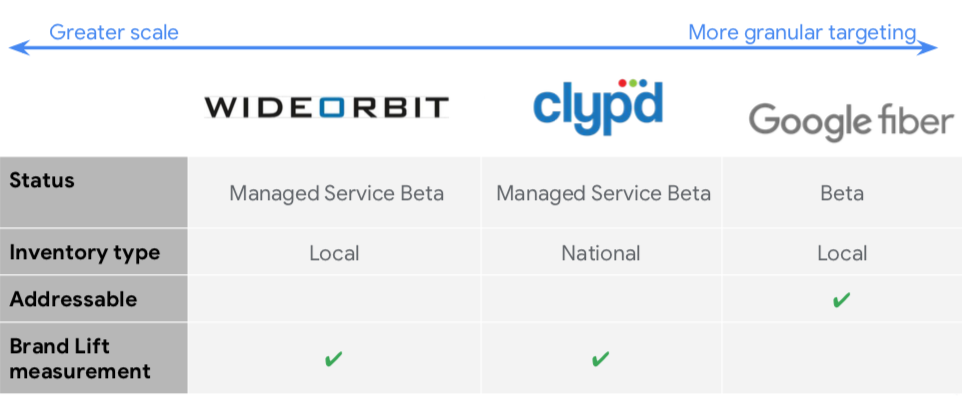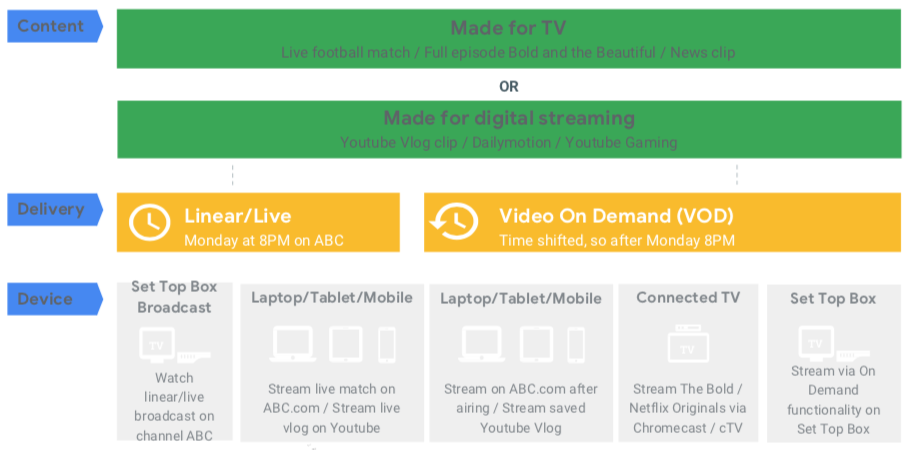 No question about it, TV content is still being viewed these days – but the viewing paradigm has changed, allowing for more precise targeting with programmatic / addressable TV advertising.
No question about it, TV content is still being viewed these days – but the viewing paradigm has changed, allowing for more precise targeting with programmatic / addressable TV advertising.
Addressable TV advertising
Addressable TV advertising allows showing unique, targeted ads to different households watching the same program. This allows for a great leap forward in TV advertising relevance & impact compared to traditional broadcast TV ad buys. Targeting options include in-market segments (e.g., auto intenders), demographics, and retargeting (based on IP address).
Google tried to sell television commercials before with Google TV Ads, a product that worked like Google Ads (previously known as Google AdWords), auctioning ad space to be delivered through set-top boxes. Google discontinued that product in 2012 after it failed to take off. Google is back at it again trying to bring addressable / programmatic ads to linear TV. The company is partnering with TV ad tech platforms Wideorbit and Clypd, and Google Fiber, which is Google’s fast internet provider. Advertisers will be able to use Google’s DoubleClick ad technology to find audiences on the available TV inventory.

Delivery & ad placement options
There are 3 fundamental delivery options for TV content where programmatic / addressable TV ads can be placed:
- Connected TV (cTV). A TV that is connected to the internet either natively (e.g., Smart TV) or via an external device (e.g., AppleTV, Roku, Chromecast, PS4, Xbox).
- 64% of households own a cTV.
- Digital TV Content (OTT) across all screens. Service that provides content which is delivered over the internet. Not interchangeable with cTV (which is a specific device) or addressable linear TV.
- TV content viewed on any device other than a cTV, or via a set top box.
- Addressable Linear TV. Served on a set top box. Live or video-on-demand (VOD).
- Traditional cable TV.
Basically, the same broadcast networks as traditional broadcast TV are all possibilities for programmatic / addressable TV ads. You can also place ads on platforms like YouTube, Hulu Live TV, DirecTV & Sling.
You can’t place ads on subscription video-on-demand (SVOD) services like Netflix, Amazon Prime Video and Hulu (the ad free version). Surprisingly, more than two-thirds of all U.S. households now have at least one SVOD service (43% have more than one), including those sharing services with others outside their household. Increased SVOD service use obviously reduces programmatic / addressable TV ad opportunities.
The number of households using only OTT to view TV content has tripled since 2013, rising to 14.1 million homes (11 % of all U.S. TV households). That’s still fewer than the 12 % of U.S. households that receive broadcast network signals via antennae.
The OTT-only number represents less than one-sixth of the 90.3 million U.S. households (74 % overall) that have a cable, telco or satellite subscription. And 70 % of households with OTT capabilities also have a cable subscription, indicating that OTT offerings are still largely supplemental for most U.S. viewers.
In the UK, SVOD services have now overtaken linear TV subscribers. Chances are the US will also be in that position soon as “cord cutting” picks up speed.
Measuring success
Reach & video ad completion reporting is now supplemented with impact-based measurement of programmatic / addressable TV ads. Impact-based measurement looks at the impact on search engine queries, as well as in-store visits.
Keyword searches motivated by your programmatic / addressable TV (or audio) ad buys, as well as your traditional broadcast ad buys, should all be covered by paid search campaigns. Ad impressions related to those keyword searches are an objective means of measuring this impact. Once upon a time you would observe organic keyword searches to measure the impact of such advertising, but Google changed the way it processes data from search, and organic keywords are now “(not provided)”. You can also look to Google Search Console queries report to observe impact on searches that generated impressions of your website URLs in Google organic search results.
Also, as users that have been exposed to your OTT delivered ads make their way physically into your stores, mobile app partnerships (e.g., Placed, Foursquare, Cuebiq) will allow measuring & reporting when that happens (similar to Google Ads store visit conversions). For business models where physical store visits are important, as this reporting technique matures, it will make for an invaluable means of justifying and optimizing programmatic / addressable TV ad spend. The increasing awareness of privacy matters will be a challenge, as will the erosion of ad placement opportunities by SVOD services.
An average TV show is 22 minutes long, allowing for 8 minutes of advertising per half hour.
